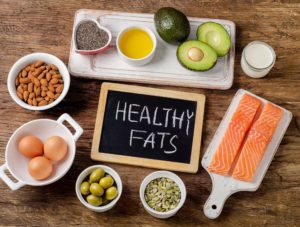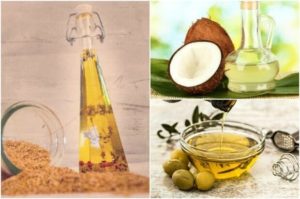Good Fat vs. Bad Fat
Since the mid-‘70s, there’s been a huge movement in our country villainizing fat as the evil behind just about every ailment known to man. Food manufacturers rushed to save us with all sorts of low-fat foods. Eggs and butter got pushed out and replaced by Egg Beaters and I Can’t Believe It’s Not Butter. Oh, and don’t forget those Snack Well’s cookies with 40% less fat.
It turns out that going low-fat seems to have made Americans fat. I know that sounds like quite the oxymoron, but let’s look a little closer at what happened.

In 1977 the United States Senate Select Committee on Nutrition and Human Needs published the first Dietary Goals for The United States. It told Americans they could improve their health and reduce their risk of heart disease by eating less fat. This “fat hypothesis” was based on a handful of ambiguous studies and a good deal of speculation. It was actually just a guess constructed by a Senate committee. By 1981 the Dietary Goals began to reshape the nutritional philosophy of America and the eating habits of most Americans. Health writers, dieticians and medical professionals began to tell us that reducing the fat in our diets would help us reduce our waistlines. This advice was based on the fact that fat contains 9 calories per gram and carbohydrates only contain 4 calories per gram.
There were a couple of problems with this. First, fat tastes good. When fat was removed, the cookies and yogurt tasted really bad. No problem, the food industry rescued the taste of these low-fat foods by adding sugar—lots of sugar. Second, fat is very satisfying; sugar isn’t. In fact, we have the ability to consume almost endless amounts of sugar in the form of processed foods. The term “Snack Well effect” was created to describe the fact that dieters will eat more low-fat cookies than regular cookies.
When Americans started eating a low-fat diet, they started getting fatter at an alarming rate. This is because we started replacing calories from fat with processed low-fat foods, which taste great, but are high in sugar and food additives.
As the low-fat movement started catching on in the ‘80s, we started replacing saturated fat in our diets with margarine, shortening, and seed oils. Saturated fat became the “bad fat,” which needed to be replaced by much healthier fats made from grains. These changes in the American diet caused obesity rates to go from 12 percent before 1980 to 25 percent in the mid-‘80s, marking the beginning of the obesity epidemic.
But what if the fat that naturally occurs in meats and vegetables isn’t bad for us? In 2010, Harvard School of Public Health performed a meta-analysis of all the studies ever compiled on the association between saturated fats and heart disease. Their study found that when carbs are used to replace saturated fats, they increased the risk for heart disease by increasing blood triglycerides and lowering HDL cholesterol levels. The study also found that there was no overall effect of saturated fat or red meat on either heart disease or diabetes.
 So, it turns out that the fat in the meat we eat is actually good for us. Look at it this way. For thousands of years, our ancestors, who were strong and healthy, killed and ate animals of all sorts. They had no regard for the amount of fat they were eating. Modern hunter-gatherer societies typically consume more than 50% of their calories from wild animals. At the same time, their saturated fat intake is about 15%, which is well above the American Heart Association’s recommendation of 7% or less.
So, it turns out that the fat in the meat we eat is actually good for us. Look at it this way. For thousands of years, our ancestors, who were strong and healthy, killed and ate animals of all sorts. They had no regard for the amount of fat they were eating. Modern hunter-gatherer societies typically consume more than 50% of their calories from wild animals. At the same time, their saturated fat intake is about 15%, which is well above the American Heart Association’s recommendation of 7% or less.
When eating meat, it’s very important to consider the source. If the meat you’re eating is locally-raised, grass-fed, without steroids or antibiotics, the fat in the meat is good to eat. If the meat you’re eating is conventionally grown, trim the excess fat because that’s where the steroids and antibiotics are typically stored.
You need a certain amount of good fats for your body to function properly. You also need to avoid eating bad fats. So how do you know if a fat is good or bad?
- A good fat exists naturally in a whole, unprocessed food.
- A bad fat is man-made.
It’s that simple. To be healthier, stop eating processed fat and stick with fats that occur naturally in food that is raised in a sensible manner. To do this you will need to stop eating seed oils that are high in polyunsaturated fatty acids.
Polyunsaturated fats are highly processed from seeds, they quickly become rancid in your body, and can dramatically increase inflammation. They should be thought of as toxic agents. Some of the damaged fat cells in polyunsaturated fatty acids get integrated into the membranes of healthy cells causing damage and dysfunction that could ultimately lead to cancer. These unstable fats can also be very disruptive to your digestive system.
Here is a list of fats you should avoid:
- Canola oil
- Corn oil
- Cotton seed oil
- Grapeseed oil
- Hydrogenated oils
- Margarine
- Partially hydrogenated oils
- Peanut oil
- Rapeseed oil
- Safflower oil
- Sunflower oil
- Soybean oil
- Trans fats
- Vegetable shortening

You’re probably saying, “Wow, is there anything left I can cook with?” Absolutely! In fact, if you switch to the following natural fats you will quickly find that your food tastes a lot better. For high-heat cooking, start using the following good fats:
- Animal fats (pork & duck have the most flavor)
- Butter (grass-fed is the best)
- Coconut oil
- Ghee (a type of clarified butter)
- Avocado oil
For low-heat cooking, try these amazing fats:
Each of the good fats listed above is linked to a brand that we particularly like. If you want to dramatically reduce inflammation, start losing weight and feel better, immediately go to your pantry and get rid of everything on our bad fat list.
Start saving bacon grease to cook with.
Stock up on butter. Grass-fed is the best.
Make sure you have coconut oil, avocado oil, and olive oil on hand at all times.
Also, each week we send out recipes that almost always include one or more of these good fats. Follow our recipes to start cooking healthier.
Stay Strong and Healthy,
Bo Railey

